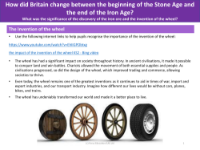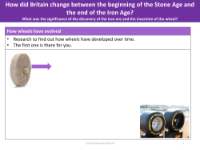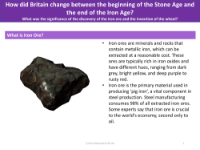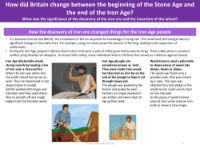How did life change after the invention of the wheel? - Picture prompts

History Resource Description
The invention of the wheel marked a revolutionary leap in the way humans lived and interacted with their environment. Prior to the wheel's existence, the movement of goods and people was limited to what could be carried or dragged, making transportation laborious and slow. The wheel's introduction brought about a transformative change, significantly easing the burden of transport. It enabled the construction of wheeled vehicles, which could carry heavier loads over longer distances with less effort. This innovation not only improved trade by allowing goods to be moved more efficiently but also enhanced mobility, leading to greater cultural exchange and the spread of ideas and technologies.
In the context of Britain, the transition from the Stone Age to the end of the Iron Age saw dramatic advancements. The Stone Age was characterised by rudimentary tools made from natural materials like wood, bone, and, of course, stone. By the end of the Iron Age, the discovery of iron ore had revolutionised tool and weapon making, giving rise to stronger and more durable implements. The wheel's invention, combined with the use of iron, facilitated improved transportation and farming methods. These developments had far-reaching implications, including the establishment of trade routes, the expansion of settlements, and the emergence of more complex societies. The wheel and the discovery of iron ore together played pivotal roles in shaping the course of human history and the development of civilisation.








